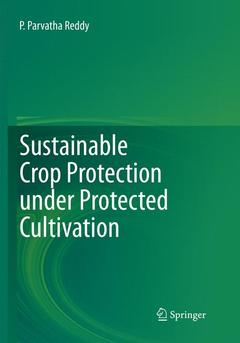Description
Sustainable Crop Protection under Protected Cultivation, Softcover reprint of the original 1st ed. 2016
Language: English
Subject for Sustainable Crop Protection under Protected Cultivation:
Publication date: 12-2018
Support: Print on demand
Publication date: 01-2016
Support: Print on demand
Description
/li>Contents
/li>Biography
/li>Comment
/li>
This book focuses on pests (insect and mite) and diseases (fungal, bacterial, viral and nematode) in protected horticulture (fruits, vegetables and ornamentals) using physical, cultural, chemical, biological, host resistance, and integrated methods. It opens with chapters describing the setting in which integrated pest and disease control operates, i.e., the greenhouse and its environment. Subsequent chapters present the basic strategies and tactics of different control methods including integrated control, with special reference to greenhouse crops. Further chapters include the different facets of biological pest and disease control ? its scientific bases, its development in practice, its commercialization and quality control. The concluding chapters of the book highlight the present status of integrated pest and disease control for the most important greenhouse crops (fruits, vegetables and flower crops) worldwide. The book?s final chapter explores future challenges for researchers assigned to identify non-pesticide methods and integrate sustainable pest management technologies that can contribute to increased productivity, such as breeding for durable resistance, biological control and devising integrated methods that will have minimal adverse environmental and social impacts.
Among productivity-enhancing technologies, protected cultivation has a tremendous potential to increase the yield of vegetables and flower cro
ps by several fold. Pests and diseases are one of the major challenges to protected cultivation. Year-round warm temperatures and relatively high humidity together with abundant food make the protected environment of greenhouses highly attractive to pests and diseases. Nevertheless, very little attention has been paid to the manipulation of greenhouse environments expressly to avoid disease epidemics and insect infestations, which together can easily account for 30% of crop losses.This book will be of immense value to all members of the scientific community involved in teaching, research and extension activities on protected horticulture. It also offers a useful reference guide for policymakers and practicing farmers, and can be used as a textbook for postgraduate courses.
1. Protected Cultivation.- 2. Greenhouse Technology.- 3. Crop Protection.- 4. Disinfestation Of Soil And Growth Media For Management Of Soil-Borne Diseases.- 5. Biological Control Of Plant Pathogens.- 6. Compost In Disease Management.- 7. Grafted Vegetables For Management Of Soil-Borne Pathogens.- 8. Biorational Pest Management.- 9. Drip Chemigation For Insect Pest Management.- 10. Selective Pesticides In IPM.- 11. Plant Diseases And Their Management.- 12. Fungal Diseases And Their Management.- 13. Bacterial Diseases And Their Management.- 14. Viral Diseases And Their Management.- 15. Nematode Diseases And Their Management.- 16. Insects Pests And Their Management.- 17. Aphids And Their Management.- 18. Thrips And Their Management.- 19. Whiteflies And Their Management.- 20. Pest And Predatory Mites.- 21. Strawberry.- 22. Tomato.- 23. Bell Pepper.- 24. Cucumber.- 25. Cole Crops.- 26. Lettuce.- 27. Rose.- 28. Carnation.- 29. Gerbera.- 30. Chrysanthemum.- 31. Gladiolus.- 32. Lilies.- 33. Orchids.- 34. Anthuriums.- 35. The Way Forward.
Dr. P. Parvatha Reddy obtained his Ph.D. degree jointly from the University of Florida, USA and the University of Agricultural Sciences, Bangalore.
Dr. Reddy served as the Director of the prestigious Indian Institute of Horticultural Research (IIHR) at Bangalore from 1999 to 2002 during which period the Institute was honored with “ICAR Best Institution Award”. He also served as the Head, Division of Entomology and Nematology at IIHR and gave tremendous impetus and direction to research, extension and education in developing bio-intensive integrated pest management strategies in horticultural crops. These technologies are being practiced widely by the farmers across the country since they are effective, economical, eco-friendly and residue-free. Dr. Reddy has about 34 years of experience working with horticultural crops and involved in developing an F1 tomato hybrid “Arka Varadan” resistant to root-knot nematodes.
Dr. Reddy has over 250 scientific publications to his credit, which also include 30 books. He has also guided two Ph.D. students at the University of Agricultural Sciences, Bangalore.
Dr. Reddy served as Chairman, Research Advisory Committee, Indian Institute of Vegetable Research, Varanasi; Member, RAC of National Research Centre for Integrated Pest Management, New Delhi; National Research Centre for Citrus, Nagpur and the Project Directorate of Biological Control, Bang
alore. He served as a Member, QRT to review the progress of AICRP on Nematodes; AINRP on Betelvine; Central Tuber Crops Research Institute, Trivandrum and AICRP on Tuber Crops. He also served as a Member of the Expert Panel for monitoring the research program of National Initiative on Climate Resilient Agriculture (NICRA) in the theme of Horticulture including Pest Dynamics and Pollinators. He is the Honorary Fellow of the Society for Plant Protection Sciences, New Delhi; Fellow of the Indian Phytopathological Society, New Delhi and Founder President


